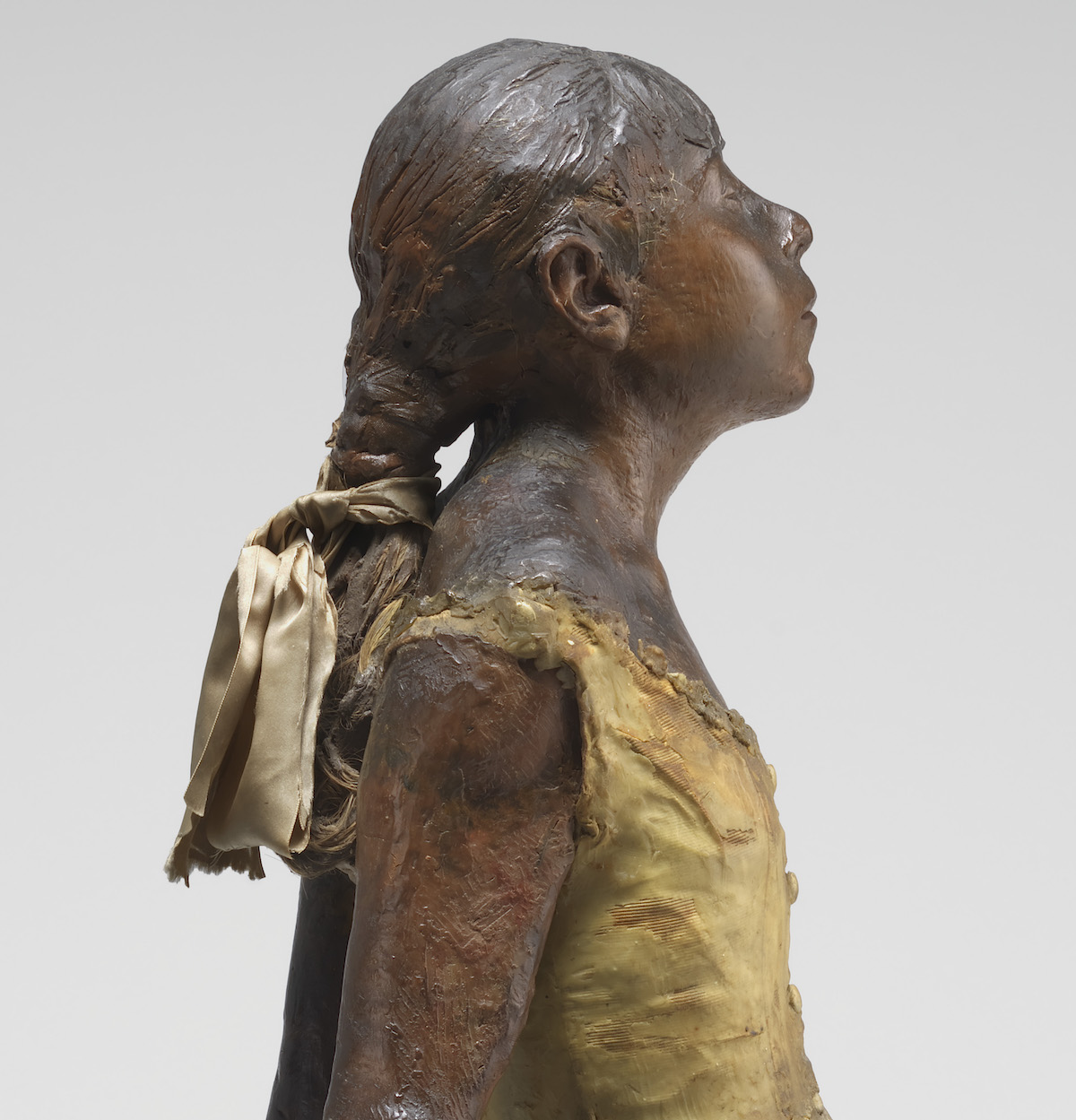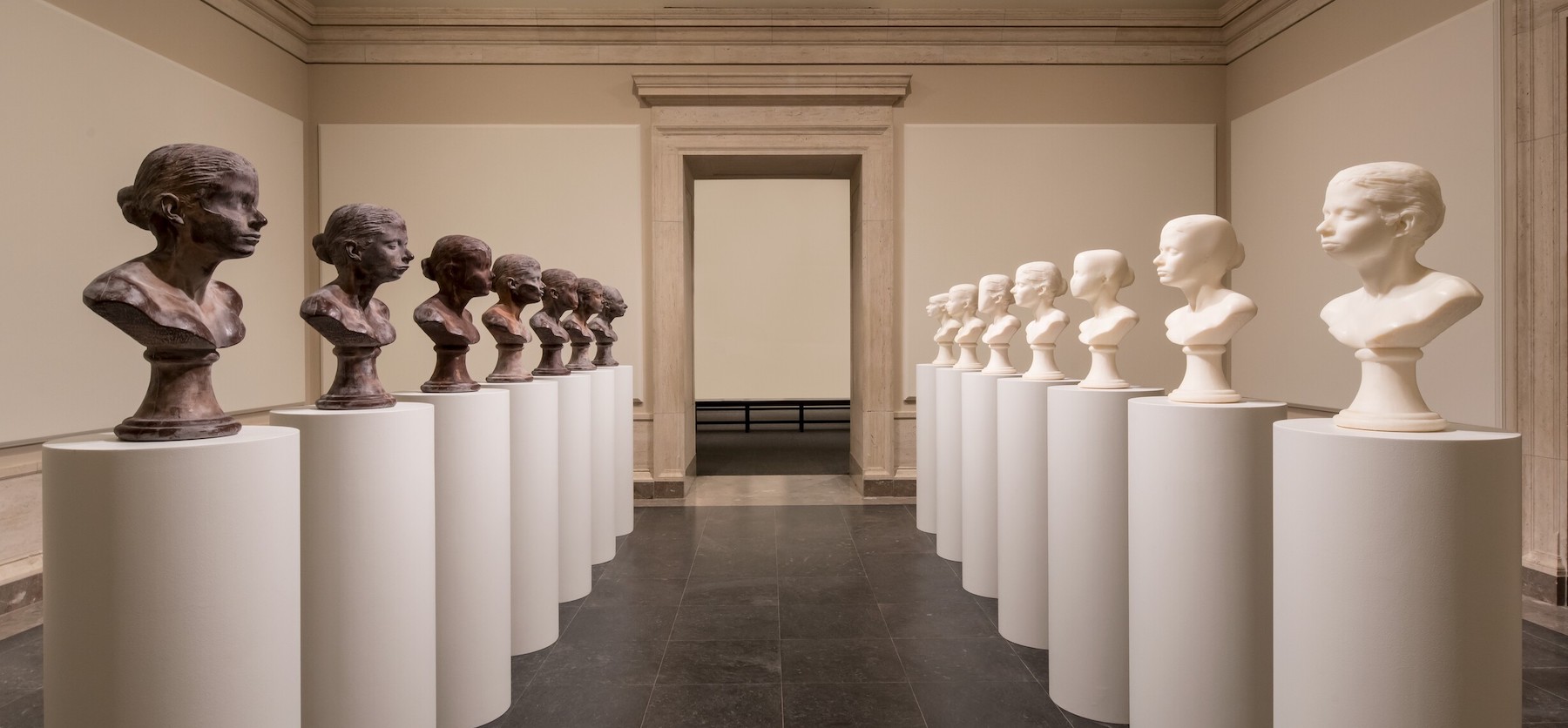Art is made from more than paint or marble. If you can imagine it, an artist has probably found a way to make a work of art with it. See how artists have used everything from eggs to soap and even to poison to make their creations.
Chocolate and soap

Janine Antoni, Lick and Lather, 1993, complete set of fourteen busts: seven in chocolate and seven in soap on fourteen pedestals, Gift of the Collectors Committee, 2016.49.1
Plenty of artists have made self-portraits. But Janine Antoni took a unique approach in her work Lick and Lather. The Bahamian American artist cast 14 busts of herself from chocolate and soap. Antoni licked the seven chocolate busts, gradually wiping away the chocolate to shape her features. She bathed with the soap busts, resulting in the same erasure. The two materials can be seen as reflections on desire (chocolate) and beauty (soap).
This isn’t the only art Antoni made of chocolate. A year before Lick and Lather she made Gnaw by chewing at two giant 600-pound blocks of chocolate and lard. Antoni then molded the chewed-up chocolate into heart-shaped packages and made 130 lipsticks from the lard (combined with pigment and beeswax).
Human hair

Edgar Degas, Little Dancer Aged Fourteen, 1878-1881, pigmented beeswax, clay, metal armature, rope, paintbrushes, human hair, silk and linen ribbon, cotton faille bodice, cotton and silk tutu, linen slippers, on wooden base, Collection of Mr. and Mrs. Paul Mellon, 1999.80.28
Some artists use materials to heighten a work’s sense of reality. French painter and sculptor Edgar Degas dressed his Little Dancer Aged Fourteen in a real cotton bodice, cotton and silk tutu, and linen slippers. But his commitment to the cause goes even further—Degas used dark blonde human hair for the dancer’s tresses. The locks were long assumed to be horsehair until our scientists studied a sample. Degas covered the hair (which he bought from a doll maker) in pigmented beeswax to meld with the rest of the sculpture.
This Little Dancer (the only one the artist made himself) is unique for its use of these unusual materials. For the rest of his wax sculptures of dancers, bathers, and horses, Degas made the hair out of wax.
Steak and gunpowder

Ed Ruscha, Stains, 1969, unbound book of seventy-five stains on wove paper, with title page, checklist, and colophon page, Gift of the Collectors Committee, 2013.60.1.1-75
In 1969 Ed Ruscha decided to conduct an experiment. The American artist felt sick of using paint. He wanted to explore how other wet materials soaked into, pooled on top, or otherwise responded to paper. Ruscha made what he called a “laundry list” of 75 different substances that he wanted to apply to wove paper, from the juice of a T-bone steak and egg yolk to gunpowder and urine.
The stain from Los Angeles tap water is nearly invisible, while Worcestershire sauce made a brown splat across the paper. The final material Ruscha tested? Stain remover.
Cyanide

Glenalvin Goodridge, Portrait of a Cat, c. 1858, ambrotype, Ross J. Kelbaugh Collection, Purchased with support from the Ford Foundation, 2023.39.11
Many 19th-century photographs were made using a lethal substance—potassium cyanide. The poisonous compound is part of the wet collodion process, used to make ambrotype and tintype photographs. Photographers coated a glass plate or metal sheet with collodion (a syrupy substance also used to bind wounds during the Civil War) and used silver nitrate to make it light sensitive. After exposing it to light in a camera, they developed the plate in an acidic solution. Finally, they set it in potassium cyanide to “fix” the image.
This process was time-intensive and inconvenient. It required many materials, and photographers had to work quickly before they dried. It was also dangerous. Potassium cyanide can be lethal when ingested, and ether used in the collodion mixture is also harmful. If a photographer made the mistake with any of these dangerous chemicals they could be gone before their photograph was even finished.
Recycled sand

Lonnie Holley, From the Beginning to the End to the Beginning, 1985, cast sand, Patrons' Permanent Fund and Gift of the Souls Grown Deep Foundation, 2020.28.6
Lonnie Holley often uses cast-off materials in his sculptures. The American artist first discovered sand at an industrial foundry where it was used for casting steel. Holley used sand to make several works, including his intricate From the Beginning to the End to the Beginning.
Holley carved figures, landscapes, and patterns into the four sides of the synthetic sandstone block. On one side are structures that look like the Manhattan skyline, Greek temples, and Egyptian pyramids. Given the title of the work, it may be a reflection of the rise and fall of lives and civilizations.
Coal

Witho Worms, Farciennes I (Chemin d'Aiseau), Belgium, 2007, carbon print, Alfred H. Moses and Fern M. Schad Fund, 2012.130.2
Dutch photographer Witho Worms makes pictures of landscapes using the very material he photographs. For his series Cette montagne c’est moi (This mountain, that’s me) Worms traveled around Europe photographing slag heaps—mounds of waste material produced by coal mining. He collected coal from each site and ground it into pigments, which he then used to print his photographs.
This carbon-printing technique dates back to the 19th-century. It was favored by many photographers including Alfred Stieglitz, who valued the method for the beautiful range of dark tones it produced. Worms chose the approach to raise questions about industrialization and its impact on our environment.
